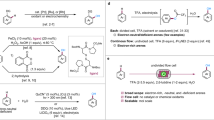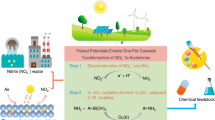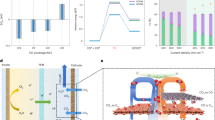Abstract
An efficient continuous flow protocol has been developed for bond C-H activation which promotes the α-cyanation of secondary and tertiary amines using magnetic nano-ferrites.
Similar content being viewed by others
Introduction
The development of environmentally mild methods for the synthesis of materials and general transformations have been receiving tremendous attention in recent years1,2,3, that entails reducing source pollution and hazardous waste generation by the chemical industry4,5. Additionally, with the increasing world population and the associated upsurge in the demand for materials, the need for chemical production will only swell6. Therefore, the development of clean, sustainable and environmental-friendly methods for the production of various chemical products is of the utmost importance7. Importantly, the elaboration of newer technologies and advancements in chemical processing can have added sustenance8. Engaged in the development of more sustainable protocols9,10,11,12,13, herein, we demonstrate the use of a simple continuous flow setup in presence of magnetic nano-ferrites (Fe3O4) for the direct oxidative cyanation of the C-H bond comprising secondary and tertiary amines.
The product of the direct oxidative cyanation of the C-H bond in secondary and tertiary amines have vast applications14 as attested by recent research efforts in this area15,16,17,18,19. This direct oxidative cyanation of the C-H bond in tertiary amines to generate the corresponding α-aminonitriles has been widely studied20,21, in view of their applications in natural products and nitrogen containing bioactive compounds, namely alkaloids22,23,24.
An array of metal-based catalytic procedures has been reported for the direct oxidative cyanation of tertiary amines15,16,17,18,19,20,21. Although they lack much to be desired in terms of environmental and economic aspects; most reactions require the use of acetic acid15,17,18,19,20,21,25. This adds more energy and time requirements, as well as increased waste generation. Newer reports entail the direct utilization of C-H bonds using metals to circumvent the multi-step synthetic procedure. Recently, Varma and co-workers have reported the C-H activation and cyanation of amines using in-house synthesized magnetic graphitic carbon nitride (Fe@g-C3N4)25. Various amines were exploited using Fe@g-C3N4 under optimized conditions to produce α-aminonitriles in high yield within a reasonable time period. Significantly, the Fe@g-C3N4 catalyst could be recovered and reused repeatedly simply using an external magnet.
This paper demonstrates the utility of magnetic nano-ferrites (Fe3O4) under continuous flow conditions to conduct the cyanation of amines within a few minutes (<10 min) in high yields; enhanced ability to quickly mix the starting materials promotes the faster reaction, quicker optimization, and the formation of selective and desired products under continuous flow conditions. Consequently, various intermediates with diverse potential applications can be synthesized easily and rapidly thus rendering the approach much more advantageous when compared to traditional one-pot synthesis.
Synthesis and characterization of catalyst
Magnetic nano-ferrites (Fe3O4) were synthesized according to reported methods26 and further characterized by X-ray powder diffraction (XRD), scanning electron microscope (SEM), energy dispersive X-ray analysis (EDX) and X-ray photoelectron spectroscopy (XPS). The XRD (Fig. 1) and SEM (Fig. 2) confirmed the formation of single-phase Fe3O4 nanoparticles. The presence of iron further supported by XPS (Figure S2) and EDX (Figure S3).
Results and Discussion
The magnetic nano-ferrites (Fe3O4) were then employed for C-H bond activation and resulting cyanation of amines in a 1/16″ (i.d. 0.8mm and 10m in length) stainless steel coiled tube flow reactor (5.03mL total internal dead volume). The coil reactor is totally immersed in a Paratherm® NF mineral oil bath. The oil bath was set upon a magnetic hot plate and continuously stirred to maintain a uniform temperature. The temperature attained by the oil bath facilitates efficient heating of the coiled reactor allowing transfer of heat via a thin film of reaction mixture flowing within the coiled tube. This allows for the reaction mixture (i.e., thin-film), coupled with the nano-ferrite catalyst, to rapidly attain the needed the reaction’s activation energy. The reaction mixture was pumped through the pre-heated coil via the inlet port using a peristaltic pump. This facilitated not only the lateral movement of the reaction mixture within the heated reaction zone, but also creates a consistent and well-mixed reaction fluid within the reactor. The reaction output was then collected at the exit port.
Several experimental trials for the cyanation of N, N-dimethylaniline were performed to establish optimized reaction conditions. All reactions were conducted in the presence of magnetic nano-ferrites (Fe3O4) by varying temperature and flow rate respectively (Table 1, entries 1–15). A reaction mixture was first prepared by dissolving N, N-dimethylaniline in a water and methanol solution (1:1 ratio). Further, 25mg of Fe3O4 catalyst, NaCN (1.1 mmol) and 30% (aq) hydrogen peroxide (1 mmol) were added (Fig. 3). This mixture was then pumped through the coil reactor at room temperature and ambient pressure. Several reactions were performed at the room temperature while varying the flow rate (and subsequently the residence time) (Table 1, entries 1–8). At flow rate of 0.9 mL min−1 and 1.0 mL min−1 (5.6 and 5.0 min residence time, respectively) traces of desired product were obtained. Decreasing the flow rate to 0.8 mL min−1 increased the conversion (Table 1, entry 7) however, further decrease to 0.7 mL min−1 did not make any difference (Table 1, entry 8). Therefore, subsequent reactions were conducted by keeping the flow rate at 0.8 mL min−1 and changing the temperature (Table 1, entries 9–12). Full conversion to the desired product was discernible at 50 °C and 0.8 mL min−1 (6.2 min residence time) (Table 1, entry 12); further increments in the flow rate while keeping the temperature at 50 °C reduced the conversion (Table 1, entries 13–15).
Upon optimizing the reaction conditions, the scope of the reaction was explored using a variety of tertiary and secondary amines (Table 2, entries 1–6). Importantly, the presence of an electron withdrawing (e.g. bromo group on ortho- and para-position; Table 2, entries 2–3) and an electron donating group (e.g. methyl group on ortho- and para-position; Table 2, entries 4–5) did not affect the reaction rate and delivered the full conversion to desired products.
A plausible mechanism has been proposed for the oxidative cyanation of amines wherein the reaction follows an oxidative and reductive mechanism. Iron (II), 1, reacts with H2O2 leading to the formation of reactive oxo-iron (IV) species, 2 which subsequently reacts with a tertiary amine to give an iminium ion, 4. This intermediate, 4, reacts with in-situ generated HCN and delivers the corresponding α-aminonitrile (Fig. 4)19.
Conclusions
Magnetic nano-ferrites coupled with a continuous flow reactor provides a protocol that has been used to arrive at a more sustainable approach for the synthesis of α-aminonitriles via C-H activation. This efficient method generates the desired products in less than 10 min of reaction. This strategy offers major improvements over previously reported methods which often require longer reaction times and higher temperatures rendering it more attractive in term of efficiency and ease of synthesis. Moreover, this approach is further simplified as the nano-ferrites can be easily separated using external magnet upon completion of the reaction. The recycled nano-ferrites can then be reused again without any demonstrated loss of its catalytic activity (Supplementary Information). Therefore, qualitatively speaking in terms of costs and energy, the developed protocol is more appealing and is an improved alternative over the conventional methods for the C-H activation.
Disclaimer
The views expressed in this article are those of the authors and do not necessarily represent the views or policies of the U.S. Environmental Protection Agency. Any mention of trade names or commercial products does not constitute endorsement or recommendation for use.
References
Anastas, P. T. & Warner, J. C. Principles of green chemistry. Green chemistry: Theory and practice, 29–56 (1998).
Clark, J. H. & Macquarrie, D. J. Handbook of green chemistry and technology. John Wiley & Sons (2008).
Varma, R. S. Greener approach to nanomaterials and their sustainable applications. Curr. Opin. Chem. Eng. 1, 123–128 (2012).
Sheldon, R. A. Fundamentals of green chemistry: efficiency in reaction design. Chem. Soc. Rev. 41, 1437–1451 (2012).
Polshettiwar, V. & Varma, R. S. Green chemistry by nano-catalysis. Green Chem.y 12, 743–754 (2010).
Armaroli, N. & Balzani, V. The future of energy supply: challenges and opportunities. Angew. Chem. Int. Ed. 46, 52–66 (2007).
Varma, R. S. Greener and sustainable trends in synthesis of organics and nanomaterials. ACS Sust. Chem. Eng. 4, 5866–5878 (2016).
Varma, R. S. Journey on greener pathways: from the use of alternate energy inputs and benign reaction media to sustainable applications of nano-catalysts in synthesis and environmental remediation. Green Chem. 16, 2027–2041 (2014).
Vaddula, B. R., Gonzalez, M. A. & Varma, R. S. Supported Ruthenium Catalysts for Sustainable Flow Chemistry. Curr. Org. Chem. 17, 2268–2278 (2013).
Vaddula, B. R., Yalla, S. & Gonzalez, M. A. An efficient and more sustainable one-step continuous-flow multi-component synthesis approach to chromene derivatives. J. Flow Chem. 5, 172–177 (2015).
Vaddula, B. R. & Gonzalez, M. A. Flow chemistry for designing sustainable chemical synthesis. Chem. Today 31, 16–21 (2013).
Gonzalez, M. A. & Ciszewski, J. T. High conversion, solvent free, continuous synthesis of imidazolium ionic liquids in spinning tube-in-tube reactors. Org. Process Res. Dev. 13, 64–66 (2009).
Tadele, K., Verma, S., Gonzalez, M. A. & Varma, R. S. A sustainable approach to empower the bio-based future: upgrading of biomass via process intensification. Green Chem. 19, 1624–1627 (2017).
Verma, D., Verma, S., Sinha, A. K. & Jain, S. L. Iron nanoparticles supported on graphene oxide: a robust, magnetically separable heterogeneous catalyst for the oxidative cyanation of tertiary amines. ChemPlusChem 78, 860–865 (2013).
Verma, S., Jain, S. L. & Sain, B. Starch immobilized ruthenium trichloride catalyzed oxidative cyanation of tertiary amines with hydrogen peroxide. ChemCatChem 3, 1329–1332 (2011).
Verma, S., Jain, S. L. & Sain, B. Acetone cyanohydrin: a convenient alternative of toxic sodium cyanide/acetic acid for oxidative cyanation of tertiary amines. Catal. Lett. 141, 882–885 (2011).
Murahashi, S. I., Komiya, N., Terai, H. & Nakae, T. Aerobic ruthenium-catalyzed oxidative cyanation of tertiary amines with sodium cyanide. J. Am. Chem. Soc. 125, 15312–15313 (2003).
Singhal, S., Jain, S. L. & Sain, B. An efficient aerobic oxidative cyanation of tertiary amines with sodium cyanide using vanadium based systems as catalysts. Chem. Commun. 2371–2372 (2009).
Singhal, S., Jain, S. L. & Sain, B. Heterogeneously catalyzed oxidative cyanation of tertiary amines with sodium cyanide/hydrogen peroxide using polymer supported iron(II) phthalocyanines as catalyst. Adv. Synth. & Catal. 352, 1338–1344 (2010).
Murahashi, S. I., Nakae, T., Terai, H. & Komiya, N. Ruthenium-catalyzed oxidative cyanation of tertiary amines with molecular oxygen or hydrogen peroxide and sodium cyanide: sp3 C-H bond activation and carbon-carbon bond formation. J. Am. Chem. Soc. 130, 11005–11012 (2008).
Murahashi, S. I., Naruyoshi, K. & Hiroyuki, T. Ruthenium‐catalyzed oxidative cyanation of tertiary amines with hydrogen peroxide and sodium cyanide. Angew. Chem. Int. Ed. 44, 6931–6933 (2005).
Opatz, T. The Chemistry of deprotonated α-aminonitriles. Synthesis 12, 1941–1959 (2009).
Isabelle, N., Kucukdisli, M. & Opatz, T. Enantioselective synthesis of α-quaternary amino acids by alkylation of deprotonated α-aminonitriles. J. Org. Chem. 80, 6864–6869 (2015).
Nicola, O. & Opatz, T. Heterocycles from α-aminonitriles. Chem. Eur. J. 20, 13064–13077 (2014).
Verma, S. et al. Magnetic graphitic carbon nitride: its application in the C–H activation of amines. Chem. Commun. 51, 15554–15557 (2015).
Baig, R. B. N. & Varma, R. S. A highly active magnetically recoverable nano ferrite-glutathione-copper (nano-FGT-Cu) catalyst for Huisgen 1, 3-dipolar cycloadditions. Green Chem. 14, 625–632 (2012).
Acknowledgements
KT and SV are Oak Ridge Institute for Science and Education (ORISE) participants at the U.S. Environmental Protection Agency, Cincinnati, Ohio. This research was supported in part by an appointment to the Postdoctoral Research Program administered by ORISE through an Interagency Agreement No, (DW-89-92433001) between the U.S. Department of Energy and the U.S. Environmental Protection Agency. No official EPA endorsement should be inferred.
Author information
Authors and Affiliations
Contributions
K.T. and S.V. designed and conducted experiments and performed data analysis. K.T., S.V., M.N.N., M.A.G. and R.S.V. wrote the manuscript. All authors reviewed the manuscript.
Corresponding authors
Ethics declarations
Competing Interests
The authors declare that they have no competing interests.
Additional information
Publisher's note: Springer Nature remains neutral with regard to jurisdictional claims in published maps and institutional affiliations.
Electronic supplementary material
Rights and permissions
Open Access This article is licensed under a Creative Commons Attribution 4.0 International License, which permits use, sharing, adaptation, distribution and reproduction in any medium or format, as long as you give appropriate credit to the original author(s) and the source, provide a link to the Creative Commons license, and indicate if changes were made. The images or other third party material in this article are included in the article’s Creative Commons license, unless indicated otherwise in a credit line to the material. If material is not included in the article’s Creative Commons license and your intended use is not permitted by statutory regulation or exceeds the permitted use, you will need to obtain permission directly from the copyright holder. To view a copy of this license, visit http://creativecommons.org/licenses/by/4.0/.
About this article
Cite this article
Tadele, K., Verma, S., Nadagouda, M.N. et al. A rapid flow strategy for the oxidative cyanation of secondary and tertiary amines via C-H activation. Sci Rep 7, 16311 (2017). https://doi.org/10.1038/s41598-017-16410-5
Received:
Accepted:
Published:
DOI: https://doi.org/10.1038/s41598-017-16410-5
This article is cited by
-
Pushing the boundaries of C–H bond functionalization chemistry using flow technology
Journal of Flow Chemistry (2020)
-
K–La–MgO as heterogeneous catalyst for synthesis of 3-(2-hydroxyethyl)-1,3-oxazolidin-2-one from diethanol amine and carbon dioxide
Clean Technologies and Environmental Policy (2018)
Comments
By submitting a comment you agree to abide by our Terms and Community Guidelines. If you find something abusive or that does not comply with our terms or guidelines please flag it as inappropriate.







